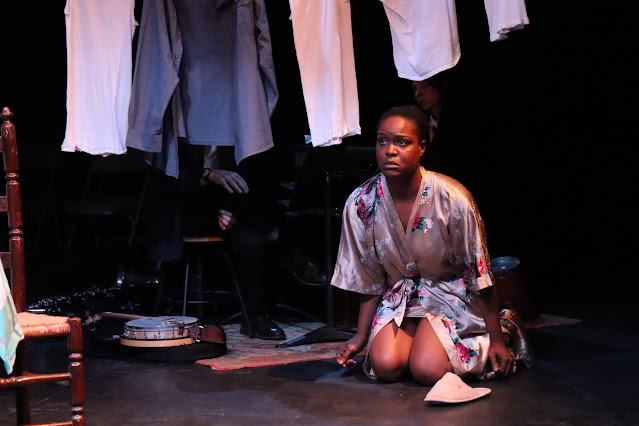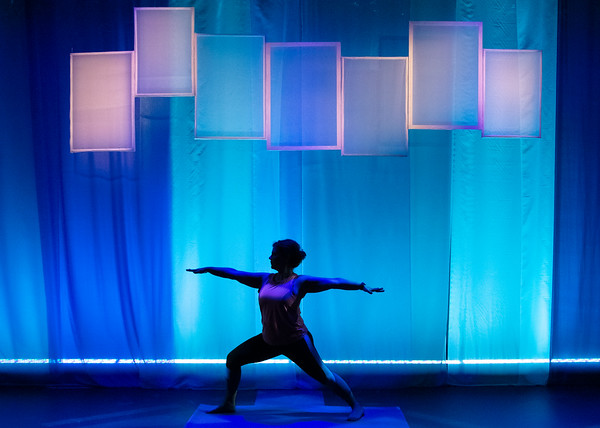Blood Orange
Directed by Vernice Miller
Associate directed and choreographed by Amelia Rose Estrada
502 W 53rd St, Manhattan, NYC
September 11-27, 2025
 |
| Ana Moioli and Maria Müller. Photo by Delia Dumont. |
Adolescence is an arduous time on its own, without its struggles and stresses being compounded by loss, abuse, or poverty, all among the additional pressures faced by the young women in Abigail Duclos's darkly intense new play
Blood Orange. In a potent production from Et Alia Theater, a company which "
uplifts multicultural, women+ centered storytelling,"
Blood Orange examines the sometimes desperate lengths to which its characters will go to in pursuit of the love and agency lacking in their lives. On roughly (though not strictly) alternating days, one of the play's four roles is played by a different actor, and the actor who plays that role in one version of the cast moves to a different role, providing more reason to experience the show's discomfiting power more than once.
 |
| Maria Müller. Photo by Delia Dumont. |
The play's driving force is high-school-aged Faye (
Maria Müller at the performance we attended), who lives in North Carolina with her step-mother, her biological mother having left her when she was a child. For Faye, her step-mother, Mariah (
Doreen Oliver), is the person who took her in and loved her when she didn't have to, but now the death of Faye's father, to whom Mariah was married, has left Mariah literally prostrate with grief: she has mostly stopped leaving her bed on the home's second story, her presence reduced to the occasional, vaguely ominous creaking of the floorboards–part of an evocative soundscape designed by Laura Pereira that includes insects, rain, and whispered voices. When we do actually see Mariah, Oliver–as well as Müller, in Faye's reactions–renders Mariah's confusion and physical weakness with heartbreaking authenticity. Faye, though, resists asking anyone for help with Mariah's condition, despite urgings from others, including her friend Eden (
Ana Moioli). Eden, who is a little younger than Faye and has her own problems at home, has been spending a lot of time with Faye, and from the play's beginning, the charged intimacy of their friendship gives off a bit of a
Heavenly Creatures vibe. Faye's other close friend is Georgia (
Giorgia Valenti at the performance we attended), whom Faye calls her best friend despite being mad at Georgia for spending time with her college-aged boyfriend instead of with Faye. In their first scene together, we see Georgia and Faye act like typical teens–Georgia hands Faye a new outfit to try on, and the pair dance to Marina and the Diamonds before retreating to the futon, Faye with a teen magazine–but even here, Faye's dancing tips over into something nearly feral, the type of untamed, transported movement that recurs much more strongly in a climactic, phantasmagorically lit scene that mixes horror with Dionysian ecstasy. Georgia considers Eden a friendless hanger-on, and worse, and tensions only rise once Georgia discovers that Faye and Eden, acting on Faye's stated desire to start a new religion of rebirth and resurrection, have begun praying to some nearly month-old roadkill that Faye brought home and gave a Latin name and keeps in the refrigerator.
 |
| Doreen Oliver and Maria Müller. Photo by Delia Dumont. |
The play's titular orange occupies a nexus of symbolism and signification, linked to everything from Faye's dead father to her roadkill god (partly a substitute for that father as well as for the divine father of Christianity) to sexual experiences, including in a sequence in which Faye and Eden's feeding each other pieces of orange assumes both a religious and an erotic charge. Orange flavoring also plays a role in an explicit story told by Faye, who talks about her sexual experiences in confrontational detail to the virginal Eden, who comes from a conservative Christian family. Georgia, meanwhile, faces inappropriate attention from her male teacher but also fervently polices possible queerness. Sexuality, in short, represents a fraught arena for these young women, and is one source of the anger that they feel and which is also fueled by grief (particularly in Faye's case) and fear (particularly in Eden's case). Faye's idea that the way to solicit love is to be in pain can be seen as entangled with the need for something to look to for aid, protection, and power, a need that Faye and Eden's feedback loop of fantasy attempts to fill in constructing their roadkill religion, complete with ritual gestures and prayers.
 |
| Giorgia Valenti. Photo by Delia Dumont. |
In a great detail, each of the three young women sees–and smells–the dead animal differently, speaking to the different forms that the divine or its equivalent can take for different people and their different needs, and the roadkill spends most of the play in a paper bag, giving the audience's imaginations plenty of time to do their macabre work. Other details, such as the intimacy of one person's foot pressed against another's or the devastation that can come from a cutting remark and be communicated in a simple expression further deepen the show's taut richness. Müller, Moioli, and Valenti are spellbinding, each giving a compellingly individual stamp to the volatile stew of protective performativity and denial, deep-rooted pain and rage, and destabilizing desire(s) shared among their characters. In the end,
Blood Orange preserves enough ambiguity around its supernaturally tinged moments to let the audience reach its own conclusions, but it leaves no question that the horrors of being a teenage girl are all too real.
-John R. Ziegler and Leah Richards







Comments
Post a Comment